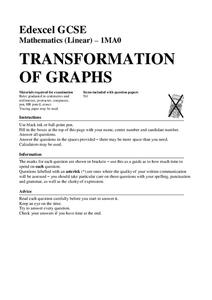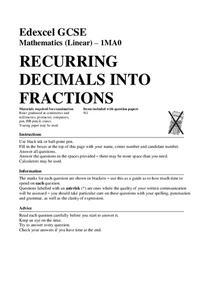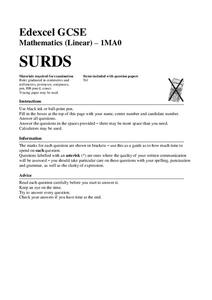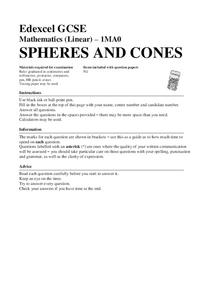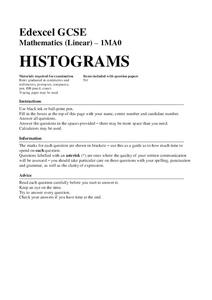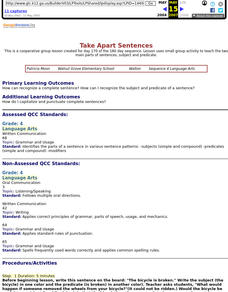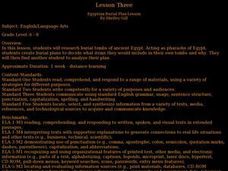Mathed Up!
Simultaneous Equations with a Quadratic
Viewers discover how to solve quadratic-linear systems with a video that first explains the substitution method for solving a system of equations involving a quadratic. Scholars then complete a worksheet of practice problems.
Mathed Up!
Transformation of Graphs
In what ways can you transform a graph? An engaging video answers this question as it covers reflections, translations, and stretches of graphs. To test their knowledge, individuals complete a set of problems to apply this knowledge.
Mathed Up!
Sine and Cosine Rules and Area of Triangles
Learners discover how to find missing sides and angles using trigonometry. Scholars first watch a video covering the Law of Sines and Cosines, as well as the area formula for a triangle. To test their knowledge, they complete a worksheet...
Mathed Up!
Recurring Decimals
Explore how to convert repeating decimals to fractions with an informative video that teaches young mathematicians how to translate between decimals and fractions. After viewing, individuals complete a set of problems to practice...
Mathed Up!
Surds
Young mathematicians learn how to simplify expressions with square roots by watching a video that shows several ways to rewrite expressions involving radicals. They work on questions where they rationalize denominators and expand and...
Mathed Up!
Direct and Inverse Proportionality
Direct your young mathematicians to a resource on direct and inverse variation. A video first reviews concepts on direct and inverse proportionality. Individuals then answer a set of questions in pure and applied mathematics...
Mathed Up!
3-D Pythagoras
Apply the Pythagorean Theorem in three-dimensional shapes. Young mathematicians watch a video that takes them through several examples of using the Pythagorean Theorem to solve problems involving lengths in three-dimensional figures. A...
Mathed Up!
Spheres and Cones
Class members learn how to apply formulas for spheres and cones with a video that begins with a review of the formulas for surface area and volume of spheres and cones. Pupils use these formulas to solve problems on a worksheet.
Mathed Up!
Histograms
Class members explore how to read and use histograms by watching a video on creating and analyzing histograms. To finish, the class works on a set of questions that tests these skills.
Curated OER
Making a Board Game: Macbeth B2
Students are given a rubic for their project on Making a Board Game. They can see how the points are broken down and what they have to do in order to recieve a great grade. Students are given 6 different categories that they can earn...
Curated OER
A Day in Japan
Sixth graders are familiarized with the Japanese culture. They note the similarities and differences between our culture and the Japanese culture. They view slideshows and websites in order to view pictures and information about the...
Curated OER
Using computers in the content area
Students practice grade appropriate computer basics and integrate them into the curriculum areas. in this technology lesson, students understand correct behaviors while using the computer. Students become familiar with the Internet...
Curated OER
Nouns and Verbs and Proper Nouns, Oh My!
Second graders identify nouns and verbs in written communication. They distinguish between between nouns, proper nouns, and verbs. Students discuss the difference between these parts of speech. In partners, 2nd graders write a sentences...
Curated OER
Marvelous Mysteries
Fifth graders explore mystery stories. For this reading and writing lesson, 5th graders complete a planning guide for an original mystery. Students use the writing process to create a mystery story.
Curated OER
Class Vacation Book
Students, utilizing technology and its avenues, create, produce and publish a variety of works. They generate a bubble map to brainstorm words that describe a specific vacation spot as well as create a pattern book with graphics about...
Curated OER
Business Letter
Students create a business letter using "Letter Generator". In this letter writing lesson plan, students use a computer program to learn what the proper business letter consists of. After the instruction, the students are...
Curated OER
If I Could Have Lived in Another Time or Culture
Third graders develop multi-paragraph compositions. They include an introduction, first and second level support, and a conclusion. They use a variety of sentence structures (e.g., simple, compound/complex) and sentence types (i.e.,...
Curated OER
Take Apart Sentences
Fourth graders explore the two main parts of sentences, subject and predicate. They, in groups, mix up their sentence strips and then place them face down and have a contest to see which group can rebuild the sentences correctly in the...
Curated OER
Egyptian Burial
Middle schoolers research burial tombs of ancient Egypt. Acting as pharaohs of Egypt, students create burial plans to decide what items they would include in their own tombs and why. They find another student to analyze their plan.
Curated OER
You've Got Mail
First graders study the postal system and letter writing. They exchange class letters with another class in a different area and become pen pals with residents in a local nursing home.
Curated OER
Paul Revere's Ride
Third graders read and discuss the selection "Paul Revere's Ride" (included with the lesson). Students imagine they live in one of the villages that Paul Revere stopped. They are awakened by his knock on the door. Students write an essay...
Curated OER
Reading Comprehension: Context Clues
Fifth graders use context clues to help them understand unknown words. In this context clues lesson, 5th graders practice identifying context clues on a worksheet, then work with a peer to write their own story. Stories are peer edited...
Curated OER
To Kill a Mockingbird - Introductory Role Play and Historical Background
Learners participate in role-play activities to explain that emotional and social effects of prejudice discussed in the novel, To Kill a Mockingbird.
Curated OER
The Very Hungry Caterpillar - Collage Technique
First graders listen to the story The Hungry Caterpillar, then sequentially organize their own re-writing and re-creating of the story. They construct illustrations for their book using the collage technique Eric Carle used in his...

